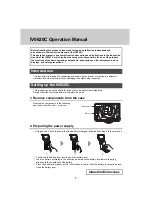
Section 10
00-02-0511
2019-07-10
11
Deviation from Average
TDXM-DC
– Deviation from Average Calculations
This example is for a 6-cylinder engine
.
Figure 1
Figure 2
Deviation from Average
Calculations
1
TDXM-DC
Channels
Enabling Channel
grPA= 6
Absolute (1
– ((2+3+4+5+6)/5))
1
Included
Absolute (2
– ((1+3+4+5+6)/5))
2
Absolute (3
– ((1+2+4+5+6)/5))
3
Absolute (4
– ((1+2+3+5+6)/5))
4
Absolute (5
– ((1+2+3+4+6)/5))
5
Absolute (6
– ((1+2+3+4+5)/5))
6
Troubleshooting Tips
If a temperature reading is incorrect, check the following:
1. Setup 1
– TC Type and Units correct?
2. Cold junction reading reasonable?
3. Install a jumper in place of the TC, should read the same as cold junction temperature.
4. Check for proper and recommended wiring practices.
A. Shielded thermocouple grade extension wire.
B. No splices involving metals other than TC type metals?
C. TC wire separation from other wiring.
5. Check for possible grounded thermocouple problems.
6. Check DC power voltage to see proper range of voltage and possible noise.
If the display shows all dashes (----------), it means all channels are set to ignore and the cold junction display is
disabled.
7. If the SP3 Latch model does not unlatch, check the following:
A. Be sure the display is in the scan mode. The unlatch operation cannot be performed while
viewing the history displays.
B. Verify that the channel in the SP3 history has cleared. To do this exit the SP history and use the
arrow keys to navigate to the channel in the scan display mode. Take note of the current
temperature and press and hold Channel SP1-3 to verify the temperature setpoint SP3 for the
channel. (See mode details on CHANNEL SP1-3 key function.)
Notes:
Figure 1, these numbers represent the data from the channels. The values that are derived are not
visible. The deviation from average calculation compares each channel to the rest of the group’s
averaged value.
Figure 1, the setting group (grPA) selects how many channels are included, from channel 1 for the
first group. The second group/starts with the first channel after the first group. These channels will be
involved in the deviation from average calculation.
Figure 2, the setpoint represents the enabling threshold (EnA or Enb). The current represents the
enabling channel(s) (EChA or EChb) (0=any channel in the group). When the enabling channel(s)
exceed the enabling threshold, the deviation from average calculations will take place.
When a channel’s deviation exceeds the deviation (dEvA or dEvb) set point, the deviated channel will
be recorded in the history.
Summary of Contents for TDXM-DC Series
Page 4: ...THIS PAGE INTENTIONALLY LEFT BLANK...
Page 13: ...Section 10 00 02 0511 2019 07 10 9 Map of Setup...
Page 14: ...Section 10 00 02 0511 2019 07 10 10 Map of Setup continued...
Page 18: ...Section 10 00 02 0511 2019 07 10 14 Notes...
Page 19: ...Section 10 00 02 0511 2019 07 10 15 Notes...
Page 20: ......






































